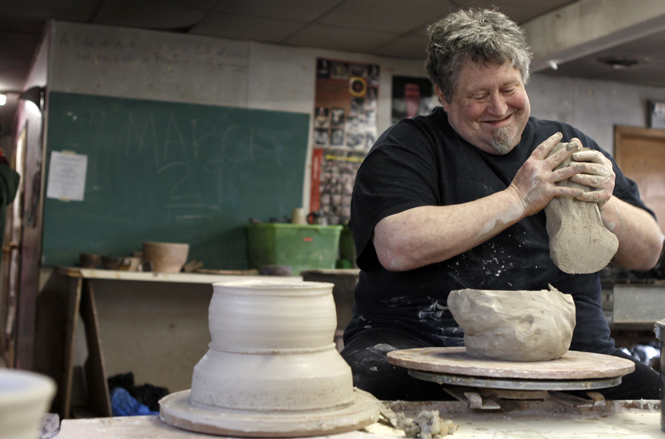Ceramics gets crafty
March 15, 2011
The term “ceramics” is defined as the practice of decorating and creating pottery; here at Kent State, it goes far beyond that.
The major covers various types of ceramics such as pottery, sculptures and functional wear.
“I immediately fell in love with clay creation and the art of making itself,” said Nick Froehlich, senior crafts major with a concentration in ceramics. Froehlich plans on pursuing a master’s degree after the semester ends.
Each clay piece is made and constructed with use of fire and glazing.
“It’s so much fun to come to class and play with mud everyday, although it requires much dedication, it’s entirely worth it,” said Rachel Stadtler, senior crafts major with a concentration in ceramics.
Commitment is exactly what the major requires.
“Sometimes things don’t go as planned and sometimes your work falls through, but you have to keep trying until you end up with a proud, well crafted, functional piece,” Stadtler said.
The ceramics students also have a certain freedom that many majors don’t. Each week the students meet up with Kirk Mangus, head of the Ceramics Department, to discuss the next project. As long as each student fulfills the requirements of the lesson, they have an abundance of flexibility on each project. Along with flexibility, Mangus pushes his students to explore all different types of crafting.
“Kirk pushes you to help you reach your fullest potential; he wants you to discover all different types of art, and he helps you develop into a true artist. He would never want you to become a copy of himself,” Stadtler said. “He’s awesome in this way.”
Mangus has influenced some of the students so tremendously that they plan on becoming teachers after college. With more and more public schools adding fine arts to the curriculum, visual arts teachers are becoming more essential.
Caty Petersilge, senior crafts major with a concentration in ceramics, hopes of emerging into a Montessori teacher after college.
“The major is not just for those who want their art displayed in galleries,” Petersilge said.
Although all ceramic majors have at least 12 credit hours of studio classes, students working toward a Bachelor of Fine Arts tend to have more specific requirements in their curriculum, where students headed for a Bachelor of Arts have more flexibility and search work in Art Education.
Many students are not aware of the opportunities that you are able to obtain through a ceramics degree. In today’s society, ceramics is one of those crafts that is often overlooked.
“It’s not a 1950s housewife skill; it’s an entire culture that has been existing for tens of thousands of years. The idea that it is like a hidden art completely fascinates me,” Froehlich said.
Ceramics classes give students not only a certain kind of freedom that they can’t acquire through other courses but a chance to express themselves through an environment that is not always accessible to the public. The creativity shown through each ceramic major is not ability but a way of life.
Contact Sarah Husbands at [email protected]























